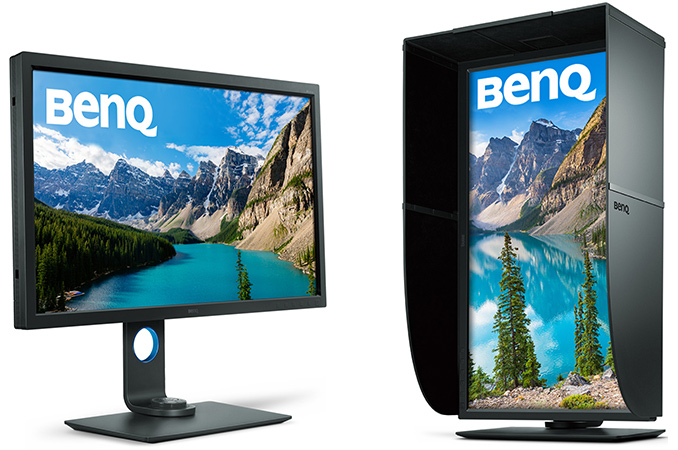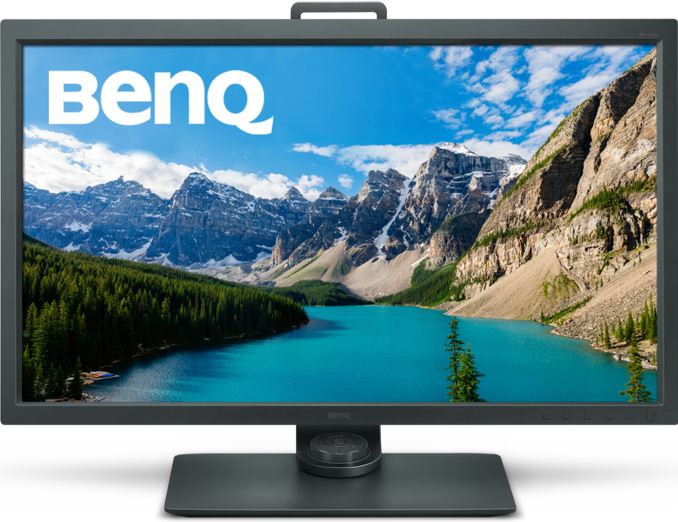BenQ Launches the SW320: a 4K Display with HDR for Professionals
by Anton Shilov on December 12, 2016 8:30 AM EST
BenQ this week introduced its new SW320 display designed specifically for professional photographers and other people who require 4K/UHD resolution, the sRGB and the Adobe RGB color spaces, and support for HDR10 capability. The monitor is calibrated directly at the factory on a per-unit basis.
The BenQ SW320 is a 31.5-inch display featuring a 10-bit IPS panel, which can reproduce 1.07 billion colors and covers 99% of the Adobe RGB, sRGB, and 87% of the DCI-P3 color spaces. The Adobe RGB color space is important for professional photographers that need to edit their photos for publications, whereas the sRGB and the DCI-P3 color spaces are crucial for video editors and animation designers who do post-production work. One of the interesting features of the SW320 is the ability to display content in different color spaces simultaneously side-by-side in PIP/PBP modes (two inputs are required).
It is worth noting that when it comes to the DCI-P3, the SW320 covers 87% of the color space, which is below 98%-99% covered by numerous displays aimed at video professionals. Meanwhile, the BenQ SW320 supports 10-bit HDR along with a 14-bit 3D LUT (look-up table) and is calibrated to DeltaE ≤ 2 in both Adobe RGB and sRGB. The support for HDR10 with proper blending accuracy is needed for those that work on adding HDR to various content, including photos and videos. BenQ cite that users involved in post-production for UHD movies (for streaming services or for Ultra HD Blu-ray media) will take advantage of the SW320.
As for the other specifications of the BenQ SW320, they look pretty standard for a high-quality 4K display: a 3840×2160 resolution with a 60 Hz refresh rate, 350 nits typical brightness, 1000:1 static contrast, 5 ms response time in fast mode and 178° viewing angles. The monitor uses a CCFL backlighting with brightness uniformity feature to ensure consistency. As for input/output capabilities, the display is equipped with one HDMI 2.0a, one DisplayPort 1.4 as well as one mDP 1.4 header (all of them support HDCP 2.2 required for various content). In addition, the SW320 is equipped with a dual-port USB 3.0 hub and a card reader that may be useful for photographers.
| BenQ SW320 | ||
| Panel | 31.5" IPS | |
| Resolution | 3840 × 2160 | |
| Refresh Rate | 60 Hz | |
| Response Time | 5 ms gray-to-gray | |
| Brightness | 350 cd/m² | |
| Contrast | 1000:1 | |
| Viewing Angles | 178°/178° horizontal/vertical | |
| Color Saturation | 100% sRGB/REC 709 99% Adobe RGB 87% DCI-P3 |
|
| Display Colors | 1.07 billion | |
| 3D-LUT | 14 bits | |
| Pixel Pitch | 0.233 mm | |
| Pixel Density | unknown | |
| Anti-Glare Coating | Yes | |
| Inputs | 1 × DP 1.4 (HDCP 2.2) 1 × mDP 14 (HDCP 2.2) 1 × HDMI 2.0a (HDCP 2.2) |
|
| USB Hub | 2-port USB 3.0 hub | |
| Card Reader | Integrated | |
| Power Consumption | Idle | 0.7 W |
| Active | 50 W | |
Just like many other professional displays, the SW320 monitor has an adjustable stand that allows rotating the panel clockwise or counter-clockwise to view the screen in portrait orientation. The BenQ SW320 comes pre-calibrated, just like competing devices, with users able to further calibrate it using the appropriate equipment.
BenQ plans to start selling its SW320 professional display in January 2017. Pricing is unknown, but since we are talking about a high-end monitor that has its own peculiarities (support for HDR and the Adobe RGB), so expect an appropriate price.
Related Reading:
- EIZO Launches ColorEdge CG2730 and CS2730 2560×1440 Displays for Professionals and Prosumers
- Dell Introduces UltraSharp UP3017 30-Inch Professional Display with 16:10 Aspect Ratio and DCI-P3 Color Space
- Dell Demonstrates 30-inch 4K OLED Display
- Philips Begins to Sell 43” 4K IPS BDM4350UC Display for $799
- 16:10 Lives On: EIZO Releases 24-inch ColorEdge CG2420 and CS2420 Professional Monitors
Source: BenQ

















16 Comments
View All Comments
zepi - Monday, December 12, 2016 - link
Seems like an odd problem that it is targeted for 4K video, yet it doesn't support the colorspace that is supposedly most appropriate for mastering the video at the moment.This seems like the first DP1.4 (or 1.3) display I've seen. I suppose this means that there are starting to be display controllers that could conceivably support higher bit-rates than the ancient DP1.2 controllers! Interesting times ahead.
nathanddrews - Monday, December 12, 2016 - link
First - yes, very exciting to see DP1.4 in the wild!Second - the colorspace support is more than sufficient to do the work needed. A native 10-bit panel with a 14-bit LUT is pretty common in the industry. When calibrated and configured for the specific needs of the project, monitors like this are perfect.
The difference between all those panels currently available and this one is the addition of native HDR support. It would be interesting to hear from an industry expert about how using an HDR monitor affects workflows. If only there were a tech website with a lot of clout that could interview someone in the business...
*hint*wink*nudge*
nathanddrews - Monday, December 12, 2016 - link
Addendum: monitors like this aren't "perfect" when compared against Sony's PVM OLED line or other SDI-equipped professional displays... but we're talking $1,500 vs $25,000...nagi603 - Monday, December 12, 2016 - link
I wish there was a 27" 1440p model. (I already have 27"+34" ultrawide setup)sanf780 - Monday, December 12, 2016 - link
Following questions might be useful for consumers with deep pockets.May I assume you still need workstation GPUs for HDR10? Do you need specific software that use OpenGL overlays (Adobe software)?
JoeyJoJo123 - Monday, December 12, 2016 - link
I think the key is that GPUs with HDMI 2.0b ports support HDR10 output, which should include RX400 series and GTX 1000 series GPUs.sanf780 - Monday, December 12, 2016 - link
I know that PS3 can deliver 12bit DeepColour, a feature introduced with HDMI 1.3. However, it never got used as even BluRays were 8bit. It was 600USD well spent at the time, as it was the first source with that feature you could buy. Also, remember that even HDMI 1.2 can do 12 bit 4:2:2, but that is clearly geared to non computer graphics.So, getting back to my question. I know Adobe Photoshop can output 10bit per channel, but it requires a Quaddro or FirePro GPU, apart from the monitor. And it only was Photoshop and few other relatively expensive software. Has anything changed in the last five years? Which software and which OS does support 10bit render? Do we even have a software video player available that can handle HDR10? Or is it only the console's and a few streaming set top boxes?
Daniel Egger - Monday, December 12, 2016 - link
31.5"... I wonder how many people have a suitable desk for that giving that the optimum viewing distance is around 1.5x the diagonal size...DanNeely - Monday, December 12, 2016 - link
It's only 2 inches wider (and half an inch shorter) than a 30" 16:10 display. 25.4x15.9" vs 27.5x15.4.Now that DP1.4 is finally starting to show up, I'm looking forward to getting either a 4k@120 or 5k@60hz display at that size to replace my venerable NEC 3090 sometime next year.
(I'd've preferred 32.5" for a closer height match with my other displays; but the panel industry appears to've skipped that size increment.)
Lolimaster - Monday, December 12, 2016 - link
IPS with their pathetic contrast and washed out colors? Any pro monitor should be RGB-OLED 3:2aspect ratio 10bits HDR.